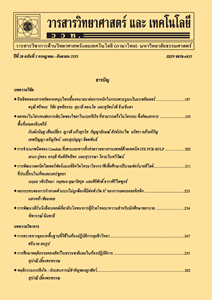กรรมวิธีการเพิ่มประสิทธิภาพในการละลายครีมเทียมผงจากแป้งข้าวด้วยวิธีการทำแห้งแบบลูกกลิ้ง
Main Article Content
Abstract
The objective was to increase the efficiency in solubility of non-dairy creamer containing rice flour under the different flour soaking times (1, 2, and 3 hours), temperatures (70, 80 and 90 °C) and maltodextrin concentrations (10 and 15 %, w/v). In this research, it was found that stability of rice flour solution was higher at the gelatinization temperature of 90 °C than that of 80 °C. Total soluble solid (TSS) of the non-dairy creamer containing 15 % (w/w) maltodextrin contents was highest with a statistical significance (p £ 05). The apparent color of all the samples was brighter (L* = 88) than that of the control (L* = 85). For morphological test, all powder samples showed facets and sharp edges as well as had more canals and porosities. In addition, the solubility of the non-dairy creamer containing 15 % (w/w) maltodextrin contents was 98 %, while the solubility of the control was 47 %.
Article Details
References
[2] Chaysuriya, K., 2015, Effect of drying process on physicochemical properties of non-dairy cream powder from rice flour, Research Project, Siam University, 66 p. (in Thai)
[3] Sirilert, T., Kamlert, S. and Boonpim, S., 2013, Study on stabilizer and emulsifier properties in non-dairy cream powder from rice and its applications, Food Technol. J. Siam Univ. 8(1): 21-34. (in Thai)
[4] Sirilert, T., Silalai, N., Chaysuriya, K. and Sarawong, C., 2017, Effect of drying process on physicochemical properties of low-calorie non-dairy cream powder from rice flour, Burapha Sci. J. 22(2): 155-168. (in Thai)
[5] Caparino, O.A., Tang, J., Nindo, C.I., Sablani, S.S., Power, J.R. and Fellman, J.K., 2012, Effect of drying methods on the physical properties and microstructures of mango (Philippine Carabao var.) powder, J. Food Eng. 111: 135-148.
[6] Sulieman, A.M.E., Abdalla, S.A. and Salih, Z., 2013, Effect of conventional and oven drying on the physicochemical properties of two tomato cultivars fruit powder, Food Publ. Health 3: 346-351.
[7] Utaphap, D., 2007, Carbohydrate Technology, Department of Biochemistry, School of Bioresources and Technology, King Mongkut’s University of Technology Thonburi, Bangkok. (in Thai)
[8] Li., J.Y. and Yeh, A.I., 2001, Relationships between thermal rheological characteris tics and swelling power for various starches, J. Food Eng. 50: 141-148.
[9] Srirod, K. and Piyajoomkwan, K., 2007, Starch Technology, 4th Ed., Kasetsart University, Bangkok, 303 p. (in Thai)
[10] Chainui, C. and Sasakul, T., 2002, Modification of rice starch containing high amylose content with pre-gelatinization and acidification methods, Master’s Thesis, Prince of Songkhla University, Songkhla. (in Thai)
[11] Rattanapanon, N., 2006, Food Chemistry, 2nd Ed, Odian Store, Bangkok, 504 p. (in Thai)
[12] Labuza, T., 1980, The effect of water activity on reaction kinetics of food deterioration, Food Technol. 34(4): 36-59.
[13] Sirisoontaralak, P. and Noomhorm, A., 2007, Changes in physicochemical and sensory-properties of irradiated rice during storage, J. Stored Prod. Res. 43: 282–289.
[14] Natchayangkul, K., 2003, Comparison of reconstituted soy protein powder from spray drying, foam drying and freeze drying techniques, Research Project, King Mongkut’s University of Technology Thonburi, Bangkok, 102 p. (in Thai)
[15] Jinapong, N., Suphantharika, M. and Jamnong, P., 2008, Production of instant soymilk powders by ultrafiltration, spray drying and fluidized bed agglomeration, J. Food Eng. 84: 194-205.
[16] Martin, S.I.F.S., Jongen, W.M.F., van Boekel M.A.J.S., 2000, A review of Maillard reaction in food and implications to kinetic modelling, Trends Food Sci. Technol. 11: 364-373.
[17] Sharma, A., Jana, A.H. and Chavan, R.S., 2012, Functionality of milk powders and milk-based powders for end use applications: A review, Compr. Rev. Food Sci. Food Saf. 11: 518-528.
[18] Baldwin, A. and Pearce, D., 2005, Milk powder, pp. 387-434, In Onwulata, C. (Ed.), Encapsulated and Powdered Foods, Taylor and Francis Group, New York.
[19] Monton, C., Kraisintu, K., Suksaeree, J., and Charoenchai, L., 2014, Flowability study of herbal powder for solid dosage form preparation, J. Sci. Technol. 22(5): 743-754.
[20] Haque, K. and Roos, Y.H., 2006, Differences in the physical state and thermal behavior of spray-dried and freeze-dried lactose and lactose/protein mixtures, Innov. Food Sci. Emerg. Technol. 7: 62-73.
[21] Abadio, F.D.B., Domingues, A.M., Borges, S.V. and Oliveira, V.M., 2004, Physical properties of powdered pineapple (Ananas comosus) juice-effect of malt dextrin concentration and atomization speed, J. Food Eng. 64: 285-287.
[22] Sommanus, K., 1995, Production of dried banana with spray drying and foam drying methods, Research Project, Kasetsart University, Bangkok, 146 p. (in Thai)


